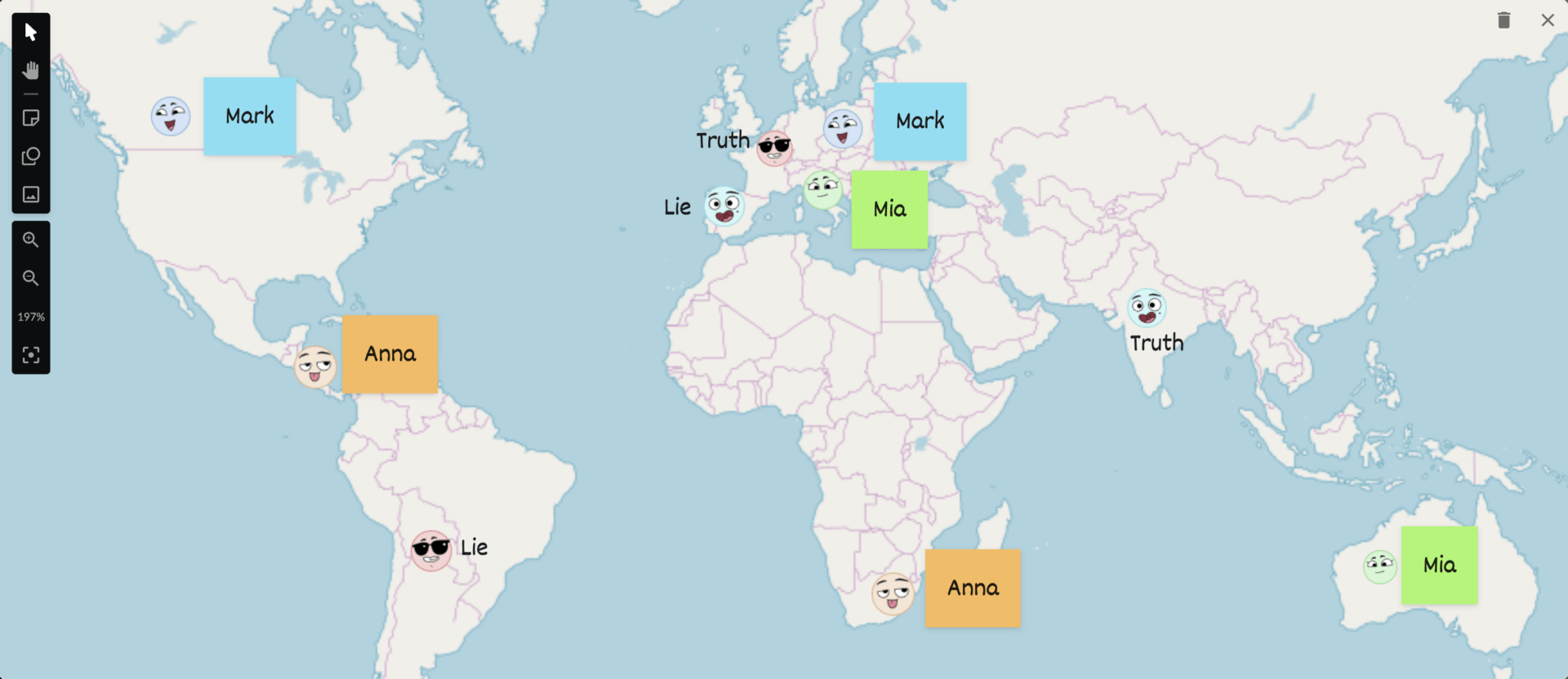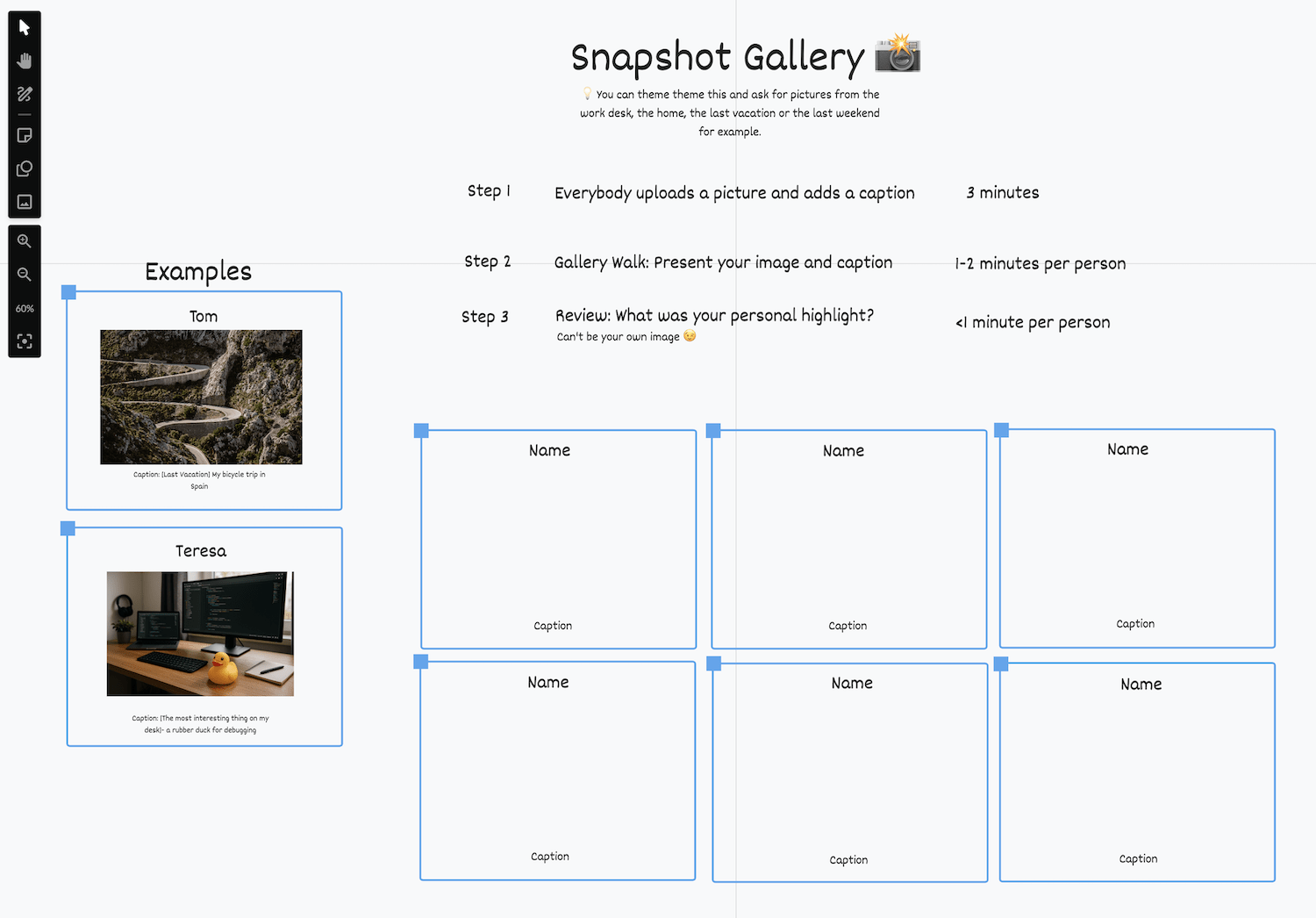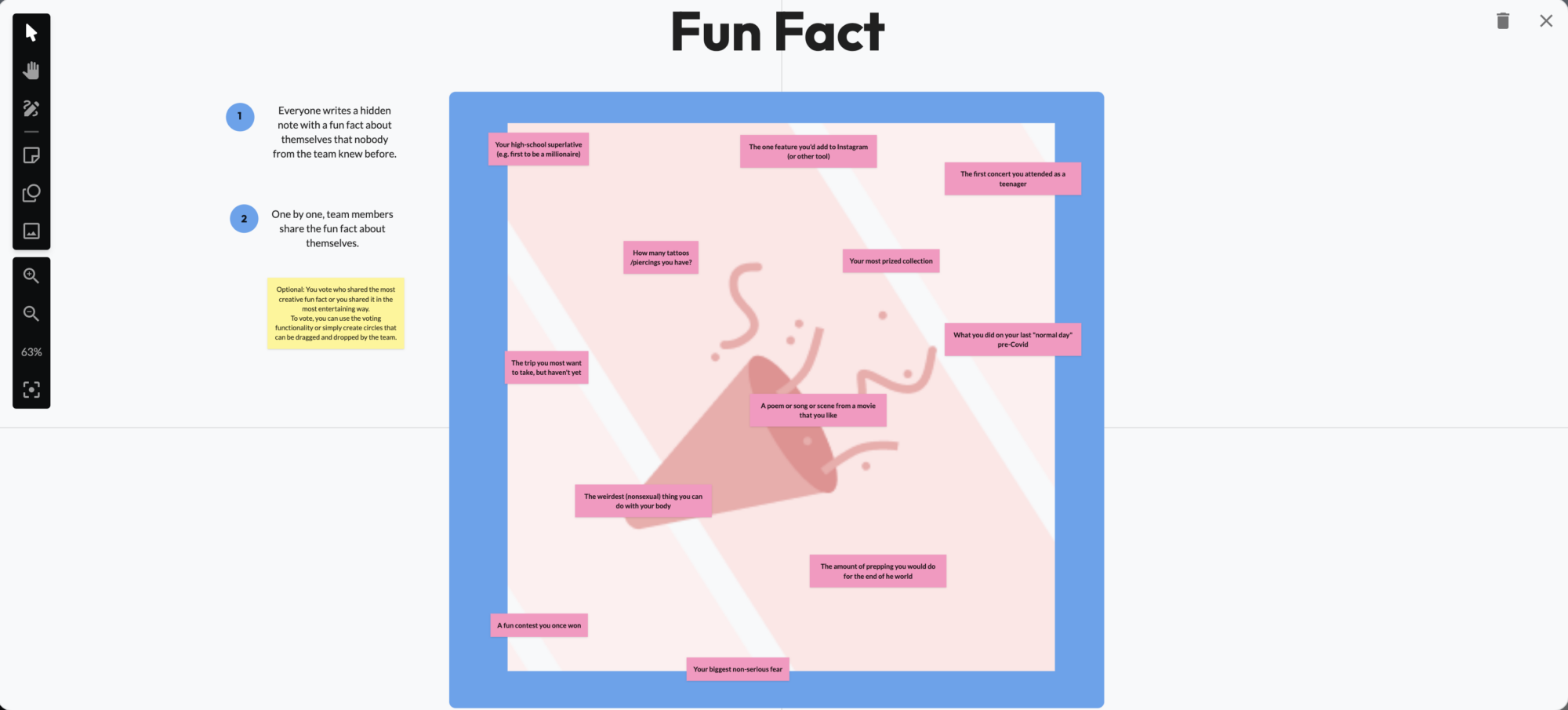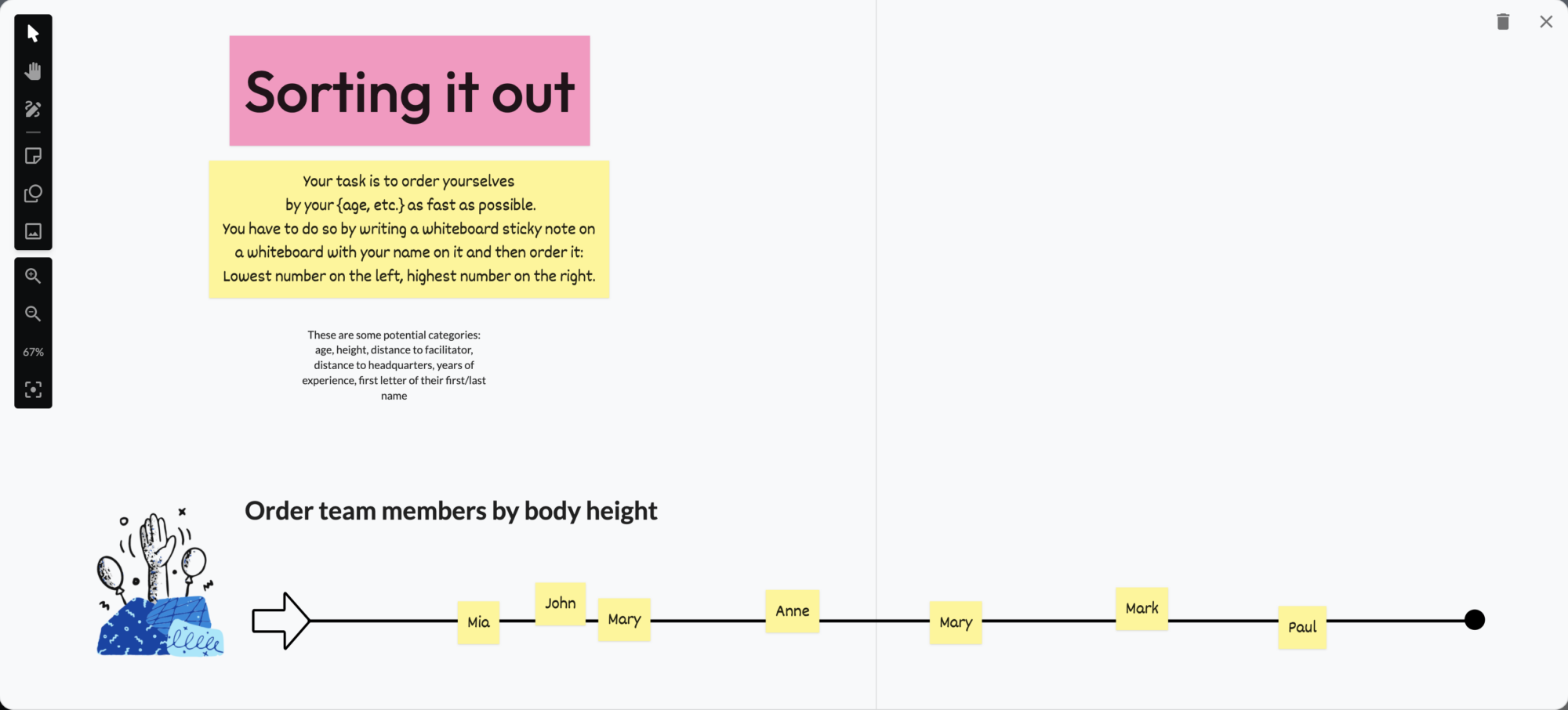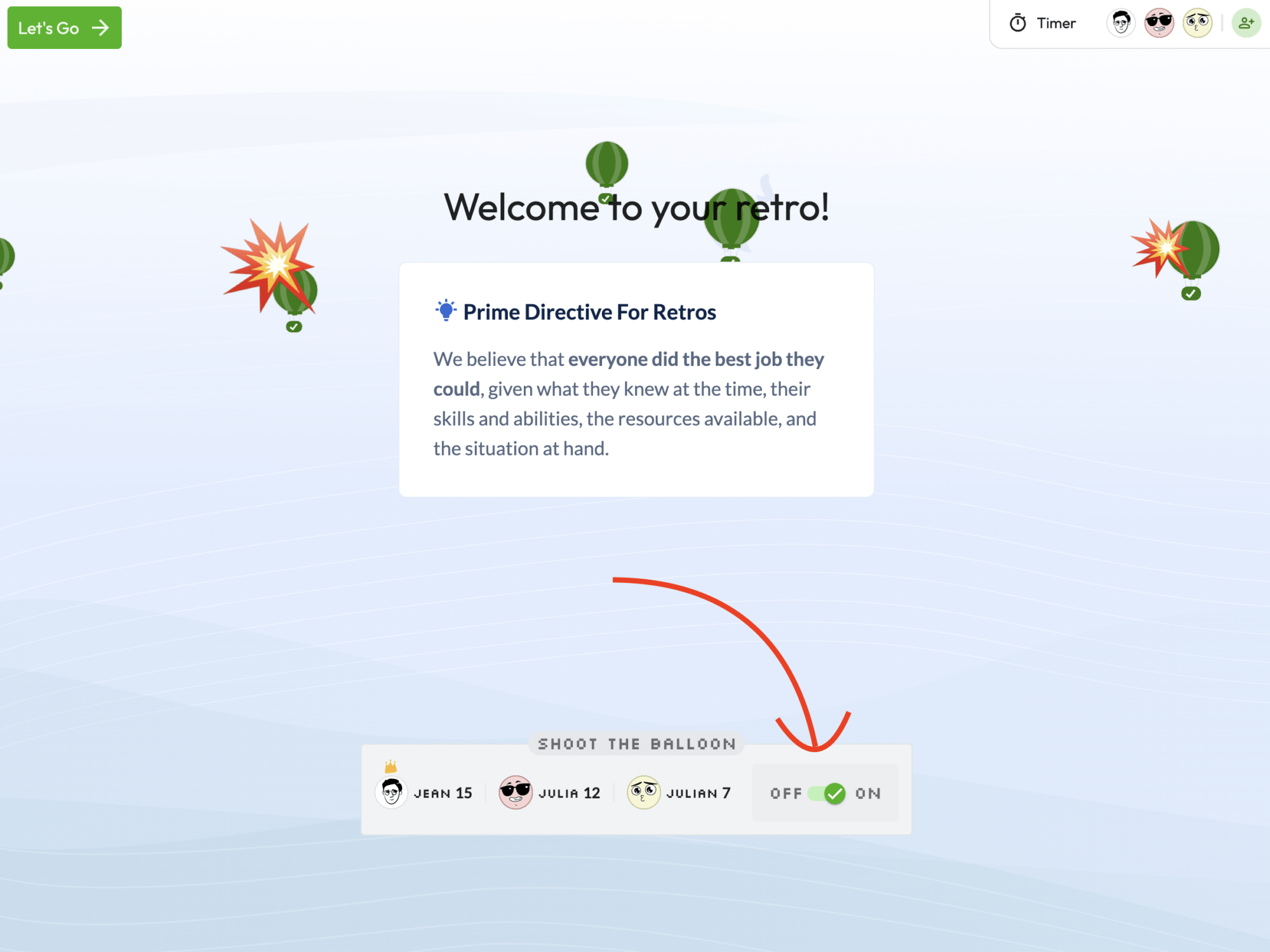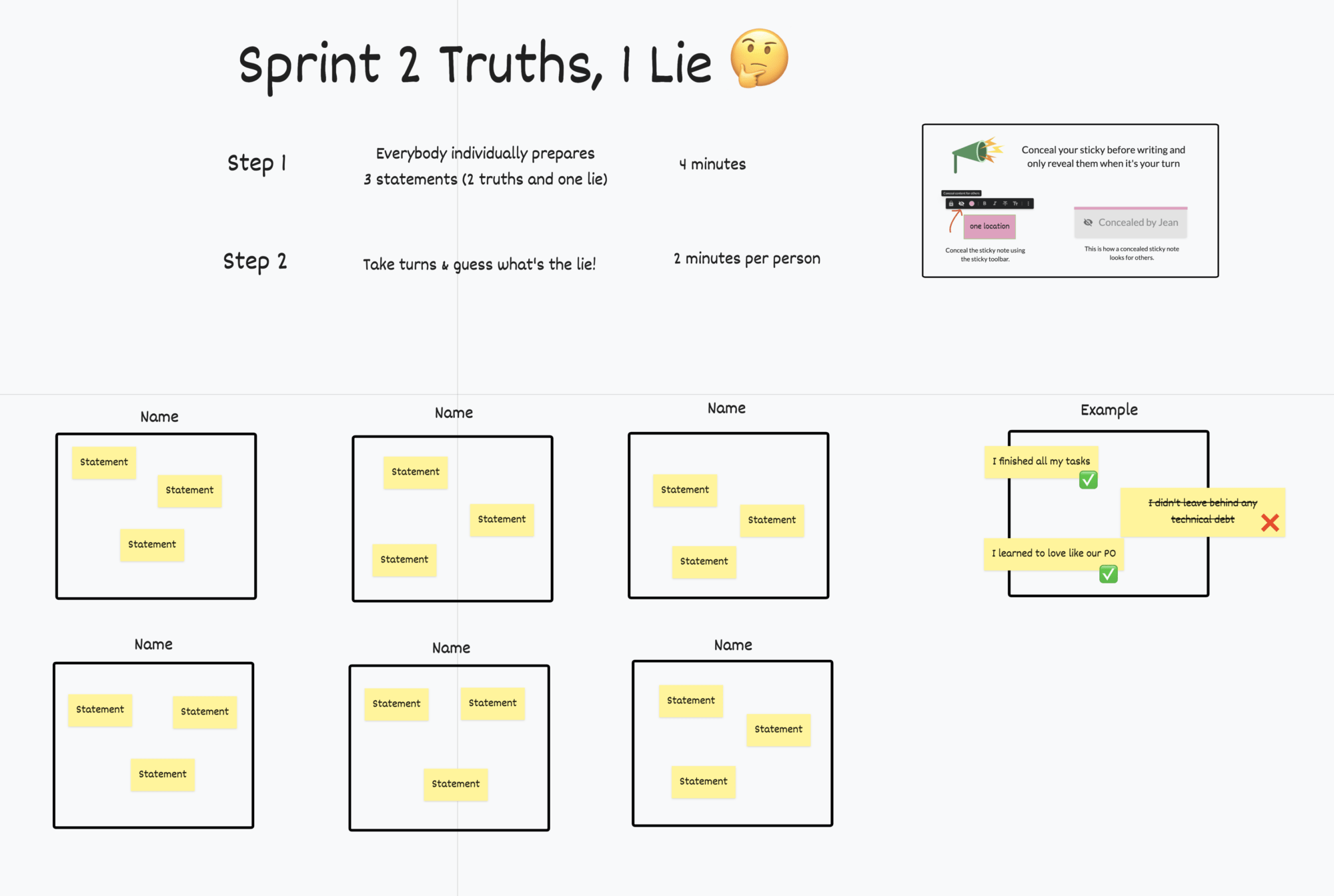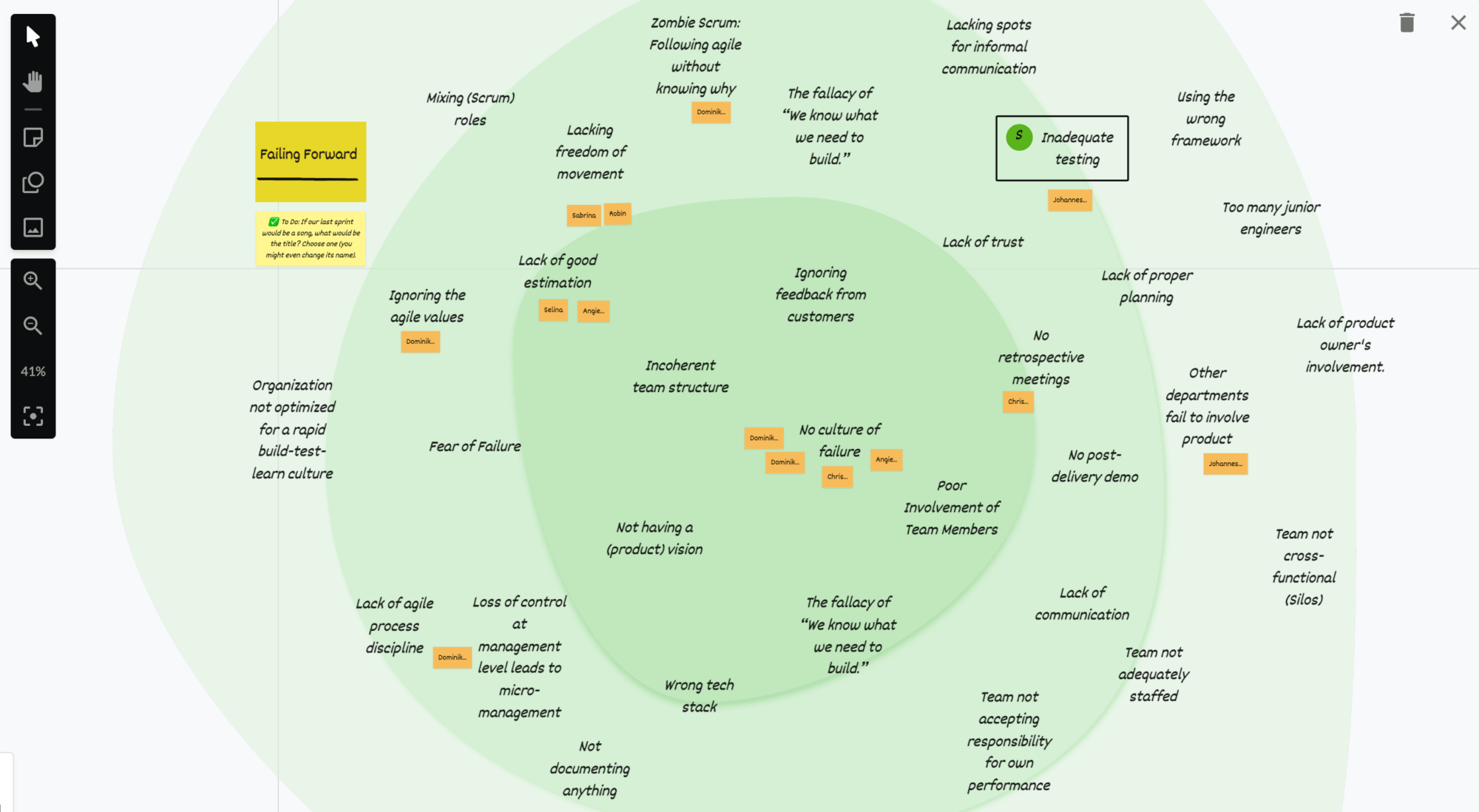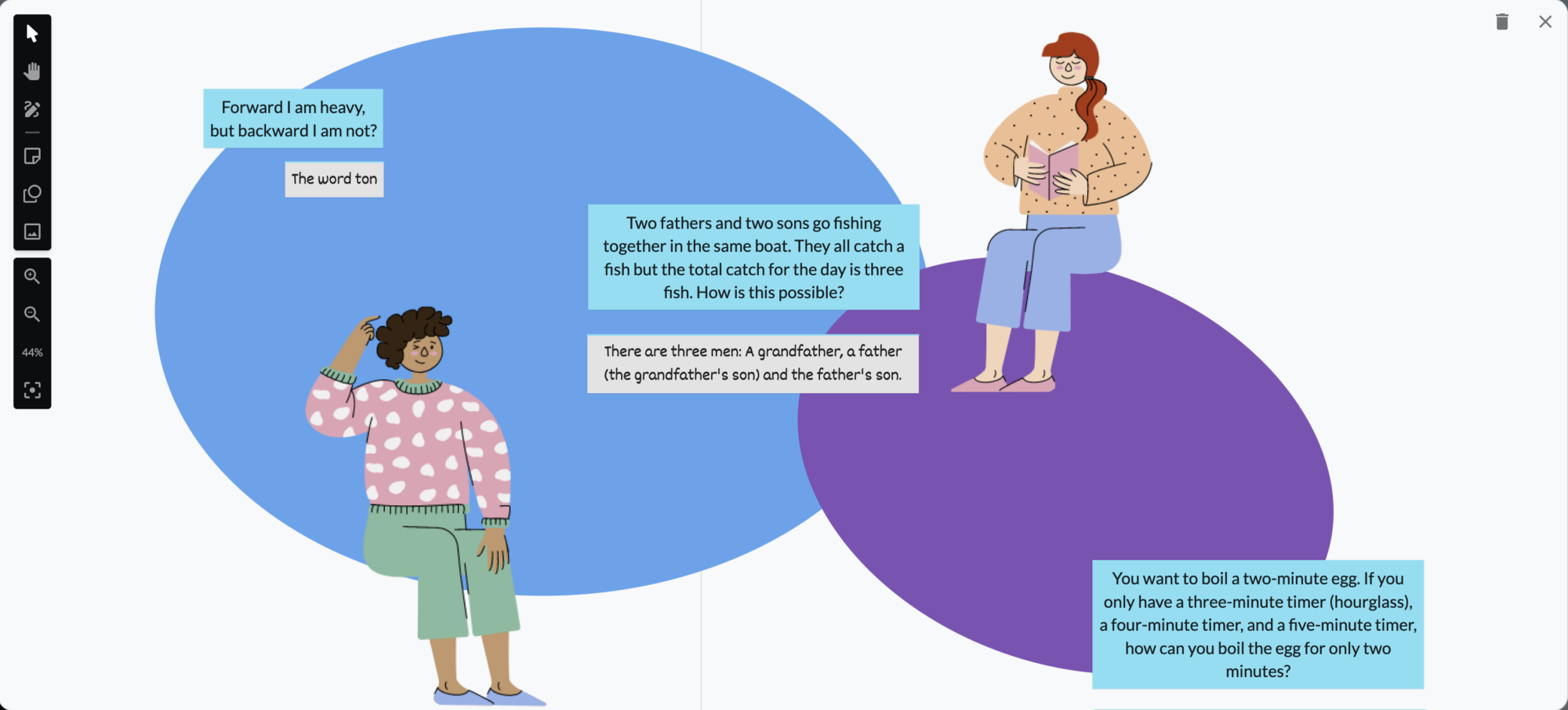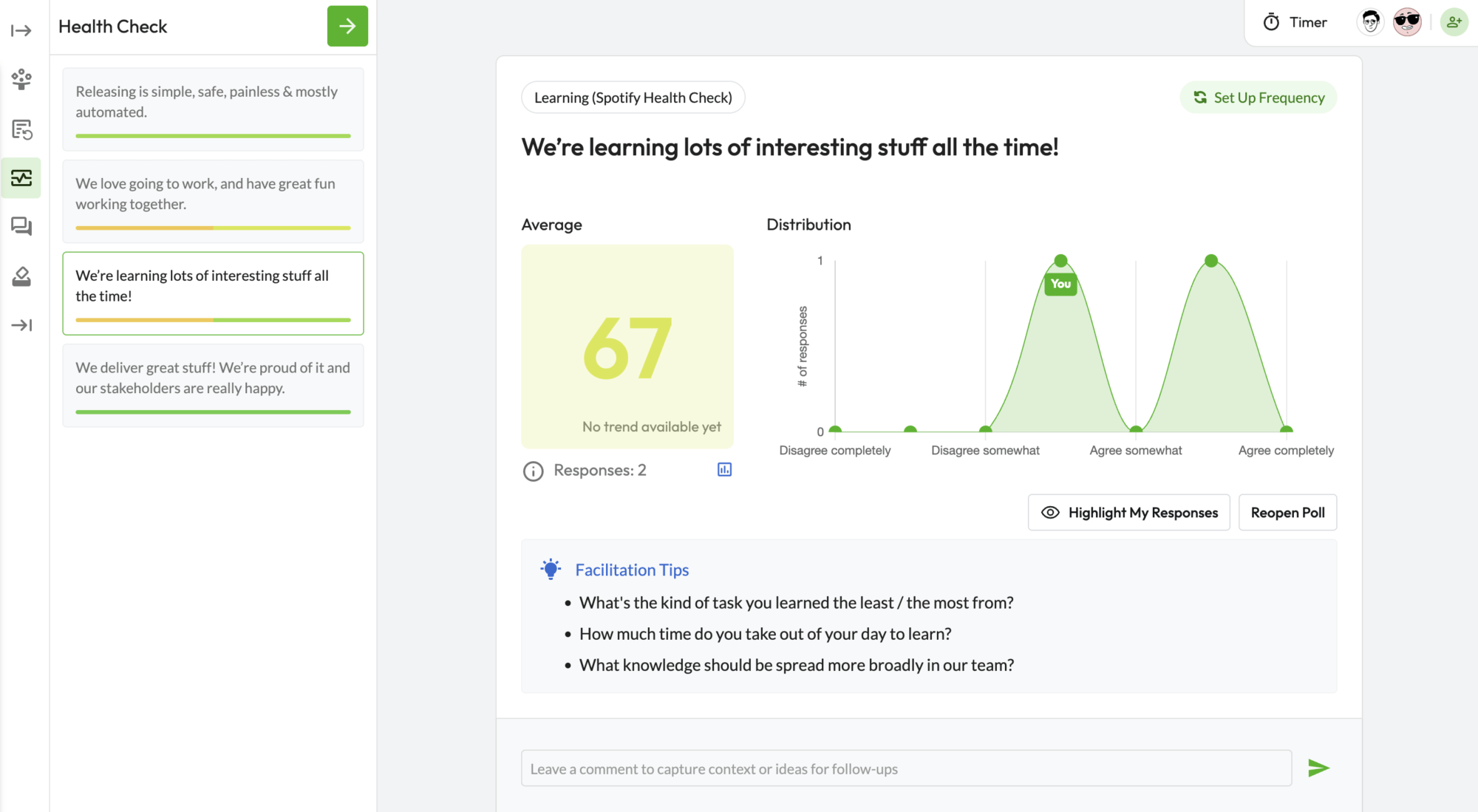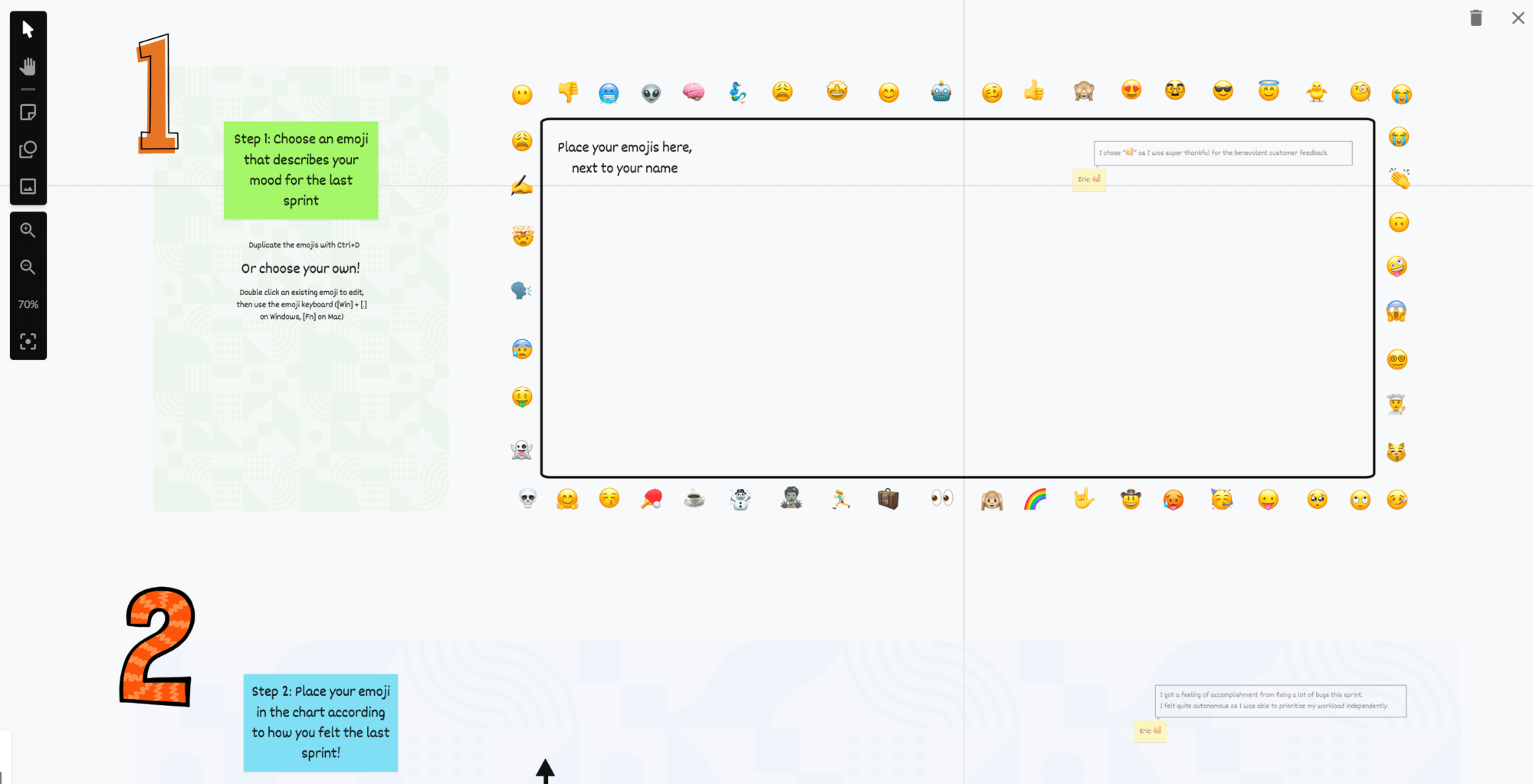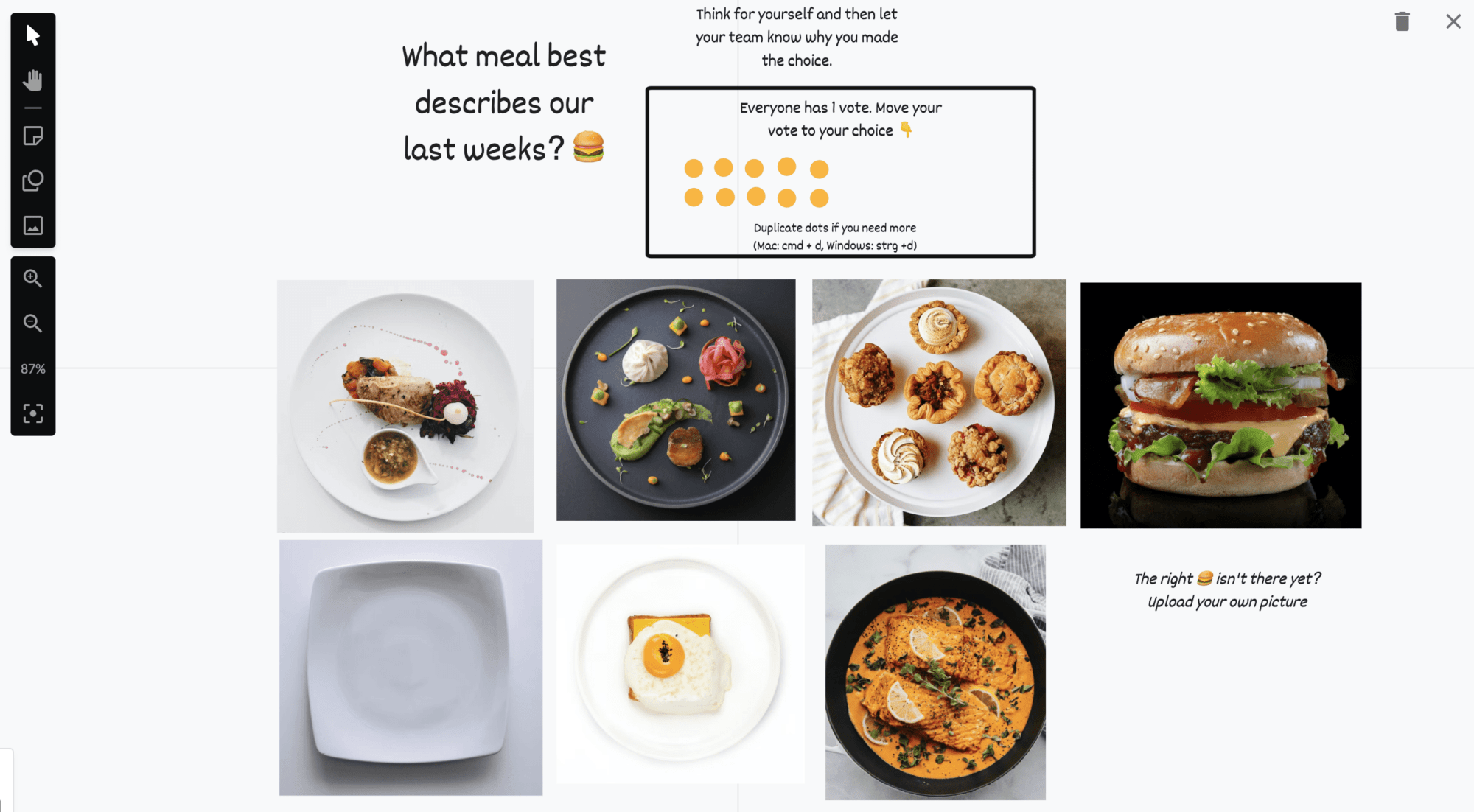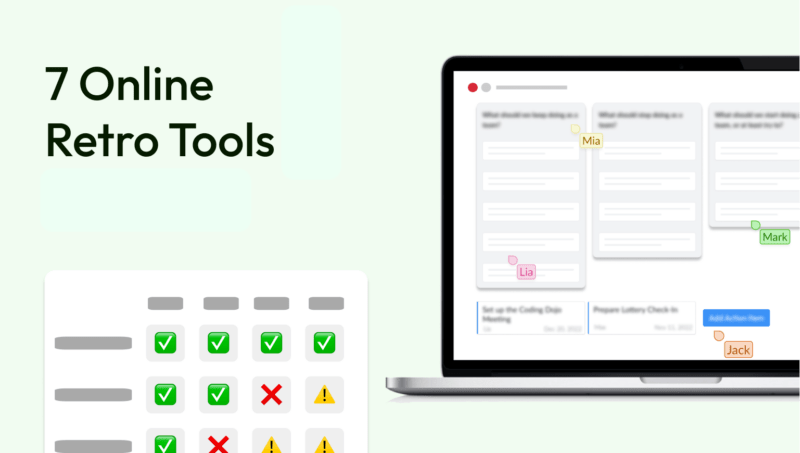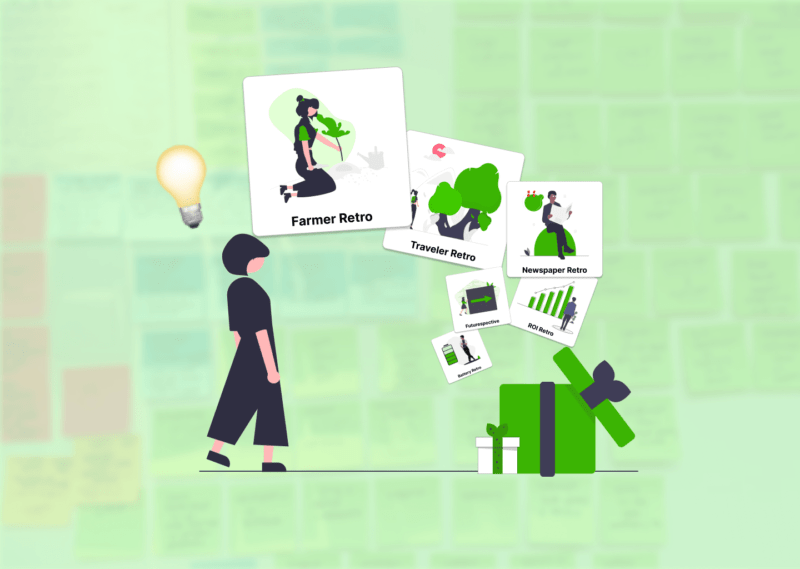Have you ever heard of this: Retrospective fatigue? In hundreds of interviews we conducted with Scrum Masters, Agile Coaches and other practitioners, Retro Fatigue was a very frequently mentioned challenge.
An obvious solution to retro fatigue: add a variety of online retrospective games!
Table of Contents
In addition to online retrospective games, there are of course some other important measures, as I explain in this article explain: 7 tips against retro fatigue. Variety in the retro and playful elements are definitely an important component!
This is where our list of the best retro games comes into play: Free Retrospective Play for Remote Teams. Alternatively, by the way, this article is also recommended: 54 Retro ideas for beginners and professionals.
We are presenting you online retrospective games that have three goals:
- 🤝 Get to know each other: The best retrospective games online to get to know each other as a team
- 💭 Reflection on the work: The best retrospective games online to reflect on the last sprint/weeks
- 🏃 Warm up: The best retrospective check-in games online to set the stage for the rest of retro (or just to do the retrospective warm up online)
Let's jump straight into the best online retrospective games! We will start with the best games to get to know each other.
🤝 Get to Know Each Other
Get to know team members better | Scrum Retrospective Games Online
It doesn't matter whether it's a young, new, large or small team: one of the goals of retrospectives is to get to know the team in a new way and to leave everyday work behind.
This is one of the reasons why there are retrospective games. They can have different foci that might help to do a retrospective warm up online or maybe even a check-out towards the end of a retro - let's have a look!
Retrospective Games for New Teams | 1
Travel truth & lies 🌎
Retro game #1 on the online whiteboard
Duration: 10-20 minutes | Aim: Getting to know each other, analyzing team communication, retrospective games for new teams
Each member of the team marks two places on a map of the world – and explains when and how they traveled there. At least one of the two journeys is a lie.
*The game is displayed in the "Icebreaker" step of the retrospective.
- Each team member marks 2 places and makes up a travel story about them (only one is real).
For example, this is what Julia Rodriguez would say:- As you all know, I was born just around the corner in New York. That's why I work here and visit my family every weekend.
- As you all know, my surname is Rodriguez. I'm actually from Mexico City, where I was born 39 years ago. My family moved to the USA shortly after my third birthday because my father started working here.
Both make sense – what's correct?
Timebox suggestion: 3 minutes. - In turn per person: The explanation for the two journeys is given one after the other. After one person has told the truth and one lie, everyone in the team guesses which travel story is true.
Timebox suggestion: 2 minutes per person.
- At the end you can delete the "lies" from the map – and you will have a nice map with the real travel stories of the team, which you can maybe even save on your common team page.
Retrospective Game Online | 2
Snapshot Gallery 📸
Retro game #2 on the online whiteboard
Duration: 5-15 minutes | Aim: Getting to know each other
Everyone shares a picture according to a certain motto. Typically popular mottos:
- Last vacation
- Last weekend
- My desk
- The most interesting object in my apartment
- My view from the window
Optionally, you can guess who uploaded which picture. Or vote on which picture is the most interesting.
*The game is displayed in the "Icebreaker" step of the retrospective.
Retrospective Game Online | 3
A Pet for Our Team 🙉
Retro game #3 on the online whiteboard
Duration: 10-15 minutes | Goal: Getting to know each other, team spirit
If your team would have a pet, which one would it be? Which name would you give it?
*The game is displayed in the "Icebreaker" step of the retrospective.
- The team can view a few different pets on a digital whiteboard. An image and a few facts about the animal is given.
- Timebox 5-10 minutes: Based on that information, the team is now supposed to choose one of these animals as their pet. Which one fits best to our team spirit, our ways of working etc.? Is it more important to us that it is an intelligent animal, or that it is fun to play with?
- What you might add: The team can choose how they approach this decision. Do you want a democratic vote? Does everyone first collect clear arguments on their own why they would go for a specific pet? Should only the two people decide with the relevant skill set: the ones that already have pets?
- [Optional step] timebox 5 minutes: Of course, you can also let the team give the pet a nice name that perfectly fits its wonderful character.
- Depending on the enthusiasm of the discussions, you might actually want to post an image of the pet with its name on your mutual team page. You have a mascot!
Fun Fact 😅
Online whiteboard game #4 (Sprint Retrospective Games Online)
Duration: 5-15 minutes | Goal: getting to know each other, check-in
Everyone tells a fun fact about themselves based on a few areas of inspiration (e.g., “When I was in school…”, “My favorite animal is not a dog, a cat or the other boring obvious choices but…”, hobby, family).
*The game is displayed in the "Icebreaker" step of the retrospective.
- You open the linked board above or make a screenshot and import it into your retrospective tool.
- Timebox 2 minutes: Everyone writes a hidden note with a fun fact about themselves that nobody from the team knew before.
- One by one, team members share the fun fact about themselves.
- The team can react via the reactions in the top right corner (at least when using the Echometer tool).
- Optional: You vote who shared the most creative fun fact or you shared it in the most entertaining way. To vote, you can use the voting functionality or simply create circles that can be dragged and dropped by the team.
The Reset 💽
Retro game #5 on the online whiteboard
Duration: 15-60 minutes | Goal: Reflecting on teamwork
Imagine you would have a fresh start as a team. Everything could be designed differently, including your own personal skill set. What would the new “us” look like?
*The game is displayed in the "Icebreaker" step of the retrospective.
- Firstly, you share the instructions with the team: Someone pressed the “reset” button. You don’t have any meetings anymore. Colleagues don’t know each other. Everything has to be set up. What is the core thing that you would do differently?
Timebox 5 -15 minutes: Next, you give the following set of questions. It is your choice if the team members should pick one of these questions and answer it - or answer all of them (which would fill the whole retrospective).- When starting over, who in our team would you like to get to know better?
- Which kind of projects, technologies or other things should the team prevent in your opinion?
- You personally could learn a new skill and develop into a new role. What skill or what role would it be?
- What would you change in how the team is organized? Which meetings would not happen that often, or not at all?
- Timebox 10 - 30 minutes: Everyone shares their replies to the questions. Which things came to mind in this thought experiment?
- You should double check if you want to include the results of the questions into the voting towards the end of the retrospective. Do we want to put down an action item based on the discussions?
Retrospective Game Online | 6
Sorting It Out 📐
Retro game #6 on the online whiteboard
Duration: 5-15 minutes | Aim: getting to know each other, warming up
The team has to find out some numeric facts about themselves as fast as possible (e.g., age, distance to facilitator) - and then order themselves by that number. Pro-level: doing this without talking.
*The game is displayed in the "Icebreaker" step of the retrospective.
- You as the facilitator choose if you want to go for one or more things that they have to find out as fast as possible. These are some potential categories: age, height, distance to facilitator, distance to headquarters, years of experience, first letter of their first/last name (in that case, you order by ABC).
- These are some possible categories: age, height, distance to facilitator, distance to your headquarters, years of experience, first letter of first/last name (in this case you sort by ABC).
- You decide whether they have to order themselves by that number/letter verbally or non-verbally (e.g., only through writing, or maybe even via the video camera).
- The instructions are given to the team:
Your task is to order yourselves by your {age, etc.} as fast as possible. You have to do so by writing a whiteboard sticky note on a whiteboard with your name on it and then order it: Lowest number on the left, highest number on the right. - At the end, you say how much time they needed and maybe share in which area they were the fasts. Interesting, how did you know your height so quickly?
Retrospective Game Online | Bonus
Chicken Shoot With Balloons 🎈
Bonus retro game in Echometer (#7)
Duration: 1-5 minutes | Goal: Fun at the end of the retro
We have built a small bonus game into our Echometer Retro Tool: Do you know the game "Chicken Shoot"? Our game works on the same principle, only with hot air balloons. It simply is about fun at the end of the retro: Which of our team members shoots the most balloons?
The screenshot above gives an overview of how the game works.
In Echometer, a retro starts on the intro screen. There are also small balloons flying along the horizon in the background. What you need to know now: As soon as any team member who is online in the remote retro clicks or shoots the balloon, the game is activated.
- Once that happened, each team member will see balloons flying back and forth at different speeds in the background of the retro check-out screen. The goal is to hit as many of them as possible.
- We recommend that you as the facilitator set a timer of 1 to 2 minutes as soon as the team starts playing.
- The winner can be identified via the counter in the upper left corner. The three team members with the most hits will be visible there. People with less points are not visible.
The goal of the game is simply to look forward to this little game at the end of the retro, on the one hand. On the other hand, you can leave the retro with a laugh through this game.
By the way: You don't have to actively promote the game. You can also just wait until one of the team members randomly clicks on the balloon and the game starts. It usually is a nice surprise 😄
💭 Reflection on the work
Reflecting on the last sprint | Scrum Retrospective Games Online
Next round! By the time you're through with these games, you should have gotten to know each other quite well as a team.
The following online retrospective games focus more on reflecting on the last sprint or the last few weeks (depending on whether you are organized in Scrum or other agile frameworks).
I would like to add one thing at this point: Regular 1-to-1 meetings or coaching sessions with your colleagues (especially combined with retrospectives) can have a decisive effect on your team performance. And they can even be data-driven! If you are interested in the topic in more detail, take a look here: Here you will find 129 one-to-one meeting (or appraisal interview) questions and Here are the 3 best one-on-one meeting tools in comparison.
A Letter to My Former Self 💌
Online whiteboard game #8 (Retrospective games ideas)
Duration: 15-20 minutes | Objective: To reflect on the findings from the last sprint
What did we learn in the sprint? What do I wish I had known beforehand? The letter to the "I" before the sprint (or alternatively the "I, before this year") is the perfect way to reflect on these questions together as a game in retrospect.
*The game is displayed in the "Icebreaker" step of the retrospective.
2 Truths and a Lie About This Sprint 🤔
Online whiteboard game #9 (Retrospective games ideas)
Duration: 15-20 minutes | Goal: Reflect on the last sprint
What did we achieve in the sprint, and what maybe we didn't? With this online retrospective game, you'll find out whether everyone has a similar level of knowledge about the sprint and can catch the lies!
*The game is displayed in the "Icebreaker" step of the retrospective.
Failing Forward 🐛
Online whiteboard game #10 (Retrospective games ideas)
Duration: 45-90 minutes | Goal: Reflecting on the teamwork in general and the last sprint
It There are so many typical mistakes made by agile teams. Why don't we just actively go through these mistakes and think about which of them apply to us? Where are we making the same mistakes that other teams have already made? Let's fail forward!
*The game is displayed in the "Icebreaker" step of the retrospective.
- A list of common mistakes or failures of agile teams is presented (see screenshot above). E.g…. You are giving the instructions.
- 4 minute timebox: Every team member reads through the typical mistakes of Scrum teams.
- 4 minute timebox: In case team members are reminded of their own team, they write a short anonymous sticky note at that position, explaining why they think so.
From now on, you proceed with the typical 5 phases of an agile retrospective. - Explaining feedback: After everyone is done with this part, everyone shares their thoughts (and notes) to get a shared understanding. At this point, there is no discussion.
- Prioritization: Every team member has 3 digital dots to vote. Put your dots where you think you have room for improvement.
- Discussion: Discuss the areas that have the most votes. Do you want to put down an action item?
- Action items: Name a specific person who is responsible for that action item. Don´t put down more than 3 action items - focus on quality instead of quantity (more on this in our post 7 tips for great action items).
- No culture of failure
- Zombie Scrum: Following agile without knowing why
- The fallacy of “We know what we need to build.”
- Not enough space for informal communication
- Using the wrong framework
- Wrong understanding of (Scrum) roles
- Lack of autonomy
- Lack of trust
- Inadequate testing
- Lack of good estimation
- Ignoring customer feedback
- Lack of proper planning
- Too many young developers
- Ignoring agile values
- Lack of product owner's involvement
- No retrospectives
- Incoherent team structure
- Other departments fail to involve product
- Fear of failure
- The organization is not optimized for a fast build-test-learn culture
- Lack of (product) vision
- Poor involvement of team members
- No sprint demo
- Team not cross-functional (silos)
- Lack of communication
- Lack of discipline regarding agile processes
- The team takes no responsibility for their own performance
- Wrong tech stack
- Team is not adequately staffed
- No proper documentation
- Loss of control at management level leads to micromanagement
The Retrospective Riddle 🕵🏻♂️
Online whiteboard game #11 (Retrospective games ideas)
Duration: 45-90 minutes | Goal: Reflecting on the teamwork in general and the last sprint
A wise wizard has 3 secret, magic questions. Answering them would help the team a lot to improve. But to get to know these questions, the team has to solve 3 riddles first.
*The game is displayed in the "Icebreaker" step of the retrospective.
- You give an overview over the agenda of today's retrospective.
- 3 minute timebox: The first riddle is presented (see whiteboard above). The team has to solve it as fast as possible. If they are faster than 3 minutes, the remaining time will be added on the time to solve the next riddle.
- 5 minute timebox: The first magic question (a creative retrospective question) from our wizard is presented. E.g.: When thinking about my team, what don't I hear that should be heard?
- 20 minute timebox: Repeat step 2 and 3 with the second and then third riddle, maybe adding the remaining time from the last round.
- Choose from your typical repertoire of retrospective questions to suggest questions. These are some suggestions of magic questions that the wizard could ask:
- When I think about my team, what am I not hearing that should be heard?
- What are you thankful for when you think about the past few weeks?
- What would James Bond do if he had the challenges we face?
- Imagine if we hadn't achieved our team goal. What would have been the reason we didn't achieve it?
- From now on you proceed with the typical 5 phases of an agile retrospective.
- Explaining feedback: After everyone has finished answering the final magic question, everyone's thoughts (and notes) are shared. At this point there is no discussion.
- Prioritization: Each team member has 3 digital points to vote on. Now put the points where you think there is still room for improvement.
- Discussion: Discuss the areas that have the most votes. Do you want to put down an action item?
- Action items: Name a specific person who is responsible for that action item. Don´t put down more than 3 action items - focus on quality instead of quantity (more on this in our post 7 tips for great action items).
- You want to boil a two-minute egg. If you only have a three-minute timer (hourglass), a four-minute timer, and a five-minute timer, how can you boil the egg for only two minutes?
- Answer: Once the water is boiling, turn the three-minute timer and five-minute timer over. When the three-minute timer runs out, put the egg in the boiling water. When the five-minute timer runs out, two minutes have elapsed and it is time to take the egg out of the water. You don't need the four-minute timer for this riddle.
- Two fathers and two sons went fishing one day. They were there the whole day and only caught 3 fish. One father said, that is enough for all of us, we will have one each. How can this be possible?
- Answer: There was the father, his son, and his son's son. This equals 2 fathers and 2 sons for a total of 3!
- Forward I am heavy, but backward I am not. What am I?
- The word Ton.
- Which of the following words don't belong in the group and why? CORSET, COSTER, SECTOR, ESCORT, COURTS
- Courts. All of the others are anagrams of each other.
- A woman shoots her husband. Then she holds him underwater for over 5 minutes. Finally, she hangs him. But 5 minutes later they both go out together and enjoy a wonderful dinner together. How can this be?
- Answer: The woman was a photographer. She shot a picture of her husband, developed it, and hung it up to dry.
- Attention, only works in English and by reading aloud: There are 30 cows in a field, and 28 chickens. How many didn't?
- Listen closely: 30 cows, and twenty-eight chickens. Say EIGHT and ATE. They sound the same. Therefore, it means 20 ATE chickens. 30-20=10, so 10 cows didn't eat any chickens.
- Sometimes I am born in silence, Other times, no. I am unseen, But I make my presence known. In time, I fade without a trace. I harm no one, but I am unpopular with all. What am I?
- Answer: A fart.
- I am six letters. When you take one away I am twelve. What am I?
- The word "Dozens".
- What type of music do rabbits listen to?
- Fun answer: Hip-hop.
Your Version of the Story 🧑🏾🏫
Online whiteboard game #12 (Project Retrospective Games)
Duration: 45-90 minutes | Goal: Reflecting on the last sprint or the last few weeks, Project Retrospective Games
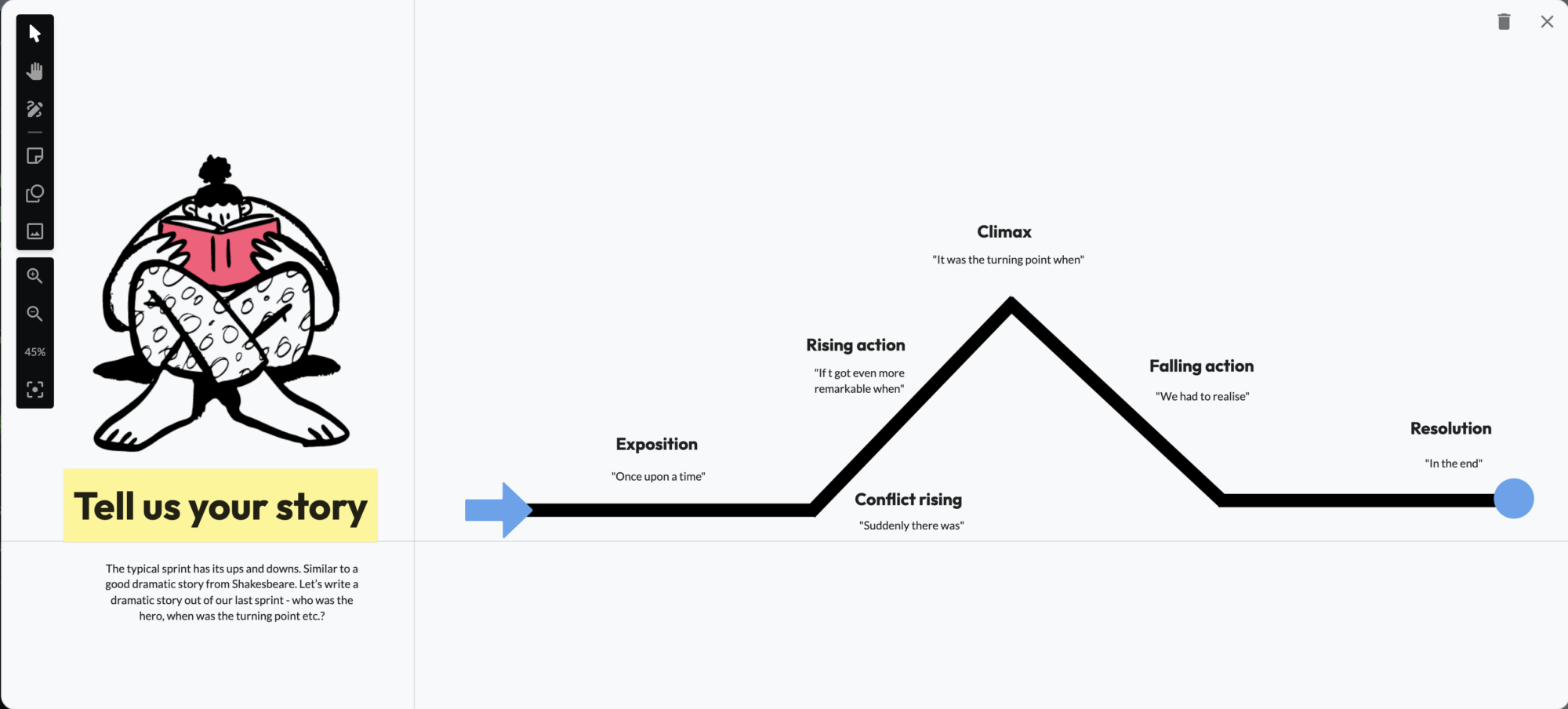
The typical sprint has its ups and downs. Similar to a good dramatic story from Shakesbeare. Let’s write a dramatic story out of our last sprint - who was the hero, when was the turning point etc.?
*The game is displayed in the "Icebreaker" step of the retrospective.
- You give an overview over the agenda of today's retrospective.
- The retrospective board with the curve of a typical drama is shared. It also includes the beginning of typical sentences that you would encounter at that stage of a story.
- 10 minute timebox: Now every team member can get creative by finishing the sentences or inventing their own sentences: “Once upon a time, a long time ago…”.
- In the best case, everyone gave their feedback on every part of the dramatic curve. One by one, every team member shares their version of the story by sharing their sentences.
From now on you proceed with the typical 5 phases of an agile retrospective. - Explaining feedback: After everyone is done with this part, everyone shares their thoughts (and notes) to get a shared understanding. At this point, there is no discussion.
- Prioritization: Every team member has 3 digital dots to vote. Put your dots where you think you have room for improvement.
- Discussion: Discuss the areas that have the most votes. Do you want to put down an action item?
- Action items: Name a specific person who is responsible for that action item. Don´t put down more than 3 action items - focus on quality instead of quantity (more on this in our post 7 tips for great action items).
Retrospective Game Online | 13
Finish the Sentence... 🔚
Retro game #13 on the online whiteboard
Duration: 45-90 minutes | Goal: Reflecting on the last sprint or the last few weeks, Project Retrospective Games
Sometimes it is easier to say something out loud after someone else created the right atmosphere to do so. This is the idea behind this retrospective game: Finish some weird, funny, creative sentences of others that make it easy to reflect on the last weeks in a fun way.
*The game is displayed in the "Icebreaker" step of the retrospective.
- 10 minute timebox, the instructions are given:
“You can find the beginning of many sentences on this whiteboard. Some of them might sound weird or crazy. But just take them as they are and try to finish some (or all) of the sentences by thinking about the last weeks/sprint.”
From now on you proceed with the typical 5 phases of an agile retrospective. - Explaining feedback: After everyone is done with this part, everyone shares their thoughts (and notes) to get a shared understanding. At this point, there is no discussion.
- Prioritization: Every team member has 3 digital dots to vote. Put your dots where you think you have room for improvement.
- Discussion: Discuss the areas that have the most votes. Do you want to put down an action item?
- Action items: Name a specific person who is responsible for that action item. Don´t put down more than 3 action items - focus on quality instead of quantity (more on this in our post 7 tips for great action items).
"Thumbs Down" 👎
Retro game #14 on the online whiteboard
Duration: 45-90 minutes | Goal: Reflecting on teamwork
Should we improve this or that? Thumbs up or thumbs down? There are a few areas in teamwork that typically have room for improvement. Let’s interactively review them by collecting “thumbs downs” to see in which area we are performing worst.
*The game is displayed in the "Icebreaker" step of the retrospective.
- In the following the team is presented with a few rough areas that are very important for successful teamwork (you don’t have to take all of them and can add other things, of course):
- Work environment, Meetings, Trust, Productivity, Commitment, Courage, Focus, Autonomy, Purpose, Respect, Work-Life balance, Communication, Decisions, Roles
- Instruction:
“Many of these area´s are pretty broad - on purpose. Simply interpret them as you like. You are now asked to give feedback on them by reacting through a “thumbs down” in the Echometer tool. Simply click on the Emoji in the upper right corner.”
Let the team click a few times to get the procedure. - Instruction:
“You might notice that the more often you click, the more the faces on the right side of the screen change and get more negative. This is the Thumbs Down-ometer. It will help us to evaluate these area’s”. - One by one, you reveal the different areas to the team on the digital Echometer whiteboard. For every area, the team is allowed to click between zero and 2 (if you have more than 6 team members) or 3 times. Write down the number that the Thumbs Down-ometer indicates after the voting (right beside the area itself).
- After every quick voting, the team members can explain why they clicked X number of times. They are always asked to share specific situations or examples to explain their choice.
- You are getting zero “thumbs downs”? That is great! Write this down and let team members explain why they are happy with this.
From now on you proceed with the typical 5 phases of an agile retrospective. - Prioritization: Every team member has 3 digital dots to vote. Put your dots where you think you have room for improvement.
- Discussion: Discuss the areas that have the most votes. Do you want to put down an action item?
- Action items: Name a specific person who is responsible for that action item. Don´t put down more than 3 action items - focus on quality instead of quantity (more on this in our post 7 tips for great action items).
A quick note at this point: If you don't know where to start with all these ideas and games for retrospectives, take a look at the following video. Our co-founder and psychologist Christian develops a ranking of the best retrospective templates – a top 10 in which there are big differences.
A Team Health Check 🩺
Retro game #15 Health Check (based on: Spotify Health Check)
Duration: 45-90 minutes | Goal: Reflecting on teamwork and agile processes
Why not do a health check in your team retrospective? It can be fun, depending on the things you ask. Everyone indicates how they view a certain topic on a scale from 1 to 7!
- You choose a number of sentences, of behaviors that you think the team could improve on in the Echometer tool. E.g., these are the things that are asked in the Spotify health check.
- Of course, you can change these questions, making some of them more fun or creative.
- Everyone indicates how much they agree to these statements on the Echometer scale from 1 to 7.
- The results are shown in the graph. Now, everyone is invited to explain the results:
“From your personal perspective, wow do you explain the highest voting? And the lowest voting?” - Once you went through all the health check items and discussed them, you proceed with the typical 5 phases of an agile retrospective.
- Explaining feedback: After everyone is done with this part, everyone shares their thoughts (and notes) to get a shared understanding. At this point, there is no discussion.
- Prioritization: Every team member has 3 digital dots to vote. Put your dots where you think you have room for improvement.
- Discussion: Discuss the areas that have the most votes. Do you want to put down an action item?
- Action items: Name a specific person who is responsible for that action item. Don´t put down more than 3 action items - focus on quality instead of quantity (more on this in our post 7 tips for great action items).
- We deliver great results! We are proud of it and our stakeholders are very satisfied.
- Our way of working suits us perfectly.
- We get things done really fast. No waiting, no delays.
- The planning of our sprints is always based on achieving the greatest possible customer benefit in the given time.
We also share unfinished work with stakeholders early on to get feedback as soon as possible.
- Each member of the development team contributes appropriately to the sprint planning.
- We are open to constructive feedback and can grow from it.
- Courage: We value people showing courage.
- Respect: We value each other’s ideas, even when disagreeing.
- Commitment: Every team member is committed to follow through on what they have promised.
- Focus: We don’t allow ourselves to be distracted from reaching the sprint goal.
- Openness: We are open to constructive feedback and grow from it.
- We have a constructive exchange of knowledge between newer and more experienced colleagues.
🏃 Warm Up
Check-Ins, Icebreakers & Warm-Ups | Scrum Retrospective Games Online
Let's continue with check-in games, which are particularly suitable for the beginning of retrospectives. This is the phase of the retrospective where most games are played.
The following exercises are rather short. Of course, you can also change them flexibly and adapt them to your context, making them even shorter or longer. I even recommend that!
Time for Emojis 🤩
Retro game #15 on the online whiteboard
Duration: 5-15 minutes | Goal: Setting the stage
Everyone chooses an emoji that describes their mood regarding the last sprint. Additionally, you indicate the subjective level of “autonomy” and “accomplishment” in a matrix.
*The game is displayed in the "Icebreaker" step of the retrospective.
- You open the whiteboard and give the simple instructions.
- 20 second timebox per person: After everyone chose an Emoji and added their name to it, they explain why they went specifically for that one.
- The next (optional) step is to duplicate their sticky note and scroll a little down further: In a matrix with the variables “autonomy” and “accomplishment”, where would you place yourself? How autonomous did you feel, how often did you have a feeling of accomplishment? This hopefully adds some more flavor to why they chose this Emoji.
- Of course, you could think about changing the names of these two variables.
- 30 second timebox per person: Everyone quickly explains their choice.
Retrospective Game Online | 16
Retrospective games for distributed teams: Sprint Animals 🐷
Retro game #16 on the online whiteboard
Duration: 5-15 minutes | Goal: Setting the stage
If our last sprint would be a face, which one would it be? Let them choose from the given images and explain their choice.
*The game is displayed in the "Icebreaker" step of the retrospective.
- You give the instructions.
- Everyone creates a sticky note with their name on it (you can also prepare this or generate them automatically in the Echometer tool). Now they position themselves on one of the images.
- The person who was the first to make a decision begins to explain their choice and hands over to the next person until everyone gave feedback.
Retrospective games for distributed teams: Eat That! 🍪
Retro game #17 on the online whiteboard
Duration: 5-15 minutes | Goal: Setting the stage
If our last sprint was a meal, which one would it be? Let the team choose from the given pictures and explain their choice.
*The game is displayed in the "Icebreaker" step of the retrospective.
One of the many fun icebreaker games for a retrospective:
- You give the instructions.
- Everyone creates a sticky note with their name on it (you can also prepare this or generate them automatically in the Echometer tool). Now they position themselves on one of the images.
- The person who was the first to make a decision begins to explain their choice and hands over to the next person until everyone gave feedback.
Retrospective Game Online | 18
Scrum Sprint Retrospective Games: Our Sprint Symphony 🎹
Retro game #18 on the online whiteboard
Duration: 5-15 minutes | Goal: Setting the stage
If our last sprint would be a song, what would be the title? Let them choose from given songs or invent their own titles.
*The game is displayed in the "Icebreaker" step of the retrospective.
One of the rather quick retrospective games:
- You give the instructions.
- 1-2 minute timebox: Everyone chooses a song title from the given list of songs (see screenshot of the whiteboard) or takes a different one.
Everyone is free to change the title of a song. For example, someone might change the title “Eye of the tiger” from Survivor to “Eye of the customer” (e.g., because they met the actual customer for the very first time). - The person who was the first to make a decision begins to explain their choice and hands over to the next person until everyone gave feedback.
- "Something Just Like This" by The Chainsmokers and Coldplay
- I Took a Pill in Ibiza by Mike Posner
- "Rolling in the Deep" by Adele
- "The Twist" by Chubby Checker
- "Yes Sir, I Can Boogie" by Baccarat
- "Party Rock Anthem" by LMFAO
- „Bad Romance“ by Lady Gaga
- „Shape of You“ by Ed Sheeran
- "Rock Around the Clock" by Bill Haley & His Comets
- "Wind of Change" by Scorpions
- "Silent Night" by Bing Crosby
- "I Gotta Feeling" by Black Eyed Peas
- "Uptown Funk" by Mark Ronson (featuring Bruno Mars)
- „Call Me Maybe“ by Carly Rae Jepsen
- "Time to Say Goodbye" by Andrea Bocelli and Sarah Brightman
- "I Don't Care" by Ed Sheeran and Justin Bieber
- Your favorite songs...
Retrospective Games in Agile: Tangram Style 🔺
Retro game #20 on the online whiteboard
Duration: 5-15 minutes | Goal: Setting the stage
To activate the creative juices in the team, you solve a tangram (a small puzzle).
*The game is displayed in the "Icebreaker" step of the retrospective.
One of the many fun retrospective meeting games:
- Share the instructions:
"This is a digital tangram, a chinese puzzle. It has to form a quadrant. Your task is to form that quadrant as a team - and you have 4 minutes to do so." - You as the facilitator should observe the team: Do you see patterns in communication that you sometimes see during the daily work? Write them down to bring them up later.
- 5 minutes timebox: Ask the team if they observed any specific team behaviors that are interesting to reflect. Who talked the most? Who talked the least and why?
- Optional: Share your own observations. If there are relevant observations, patterns you see for the actual sprint communication, include these in the second part of the retrospective: Prioritizing feedbacks and creating action items.
Fun Retro Games Agile: Movie Time 🍿
Retro game #20 on the online whiteboard
Duration: 5-15 minutes | Goal: Setting the stage
If our last sprint was a movie, what would the title be? Let the team choose from predefined films or invent their own titles.
*The game is displayed in the "Icebreaker" step of the retrospective.
One of the simple, good retrospective games:
- You give the instructions.
- 1-2 minute timebox: Everyone chooses a movie title from the given list of songs (see screenshot of the whiteboard or toggle below) or takes a different one.
Everyone is free to change the title of a movie. For example, someone might change the title “Lord of the rings” to “Lord of the bugs”. That’s a funny one. - The person who was the first to make a decision begins to explain their choice and hands over to the next person until everyone gave feedback.
- Gold fingers
- Titanic
- Lord of the Rings
- Back to the future
- Rain man
- Avatar
- The Birth of a Nation
- Indiana Jones and the Last Crusade
- Paranormal Activity
- 20,000 Leagues Under the Sea
- Furious 7
- Gone with the wind
- Doctor Zhivago
- Spider-Man: No Way Home
- ET the Extra-Terrestrial
- ...
Aiaiai, that was quite a few games. But we plan to publish even more new retrospective ideas in the future! So feel free to register for our Newsletter or to save this website to your favorites.
By the way, if you want to develop your team holistically, then you also need to improve psychological safety in the team. In this video, our co-founder Christian explains 4 team and one-to-one exercises you can do to increase psychological safety.
Even More Scrum Retro Games?
Seriously, you want even more cool retrospective games? Okay, more inspiration is probably not such a bad idea.
In that case, you should probably have a look at our 32 kickass retrospective ideas for beginners and professionals. You'll find some retrospective formats based on games, and other creative retrospective questions that you probably haven't tried yet in there. There are even some fun agile retrospective games for the different team development phases.
Other than that, I recommend to have a look at tastycupcakes retrospective games, geekbot retrospective games or retrospective games miro on Google - this should give you some more material, independent of your team development phase.
In case you are looking for kanban retrospective games, you should check out our Kanban retrospective format - it might be a good fit.
Here are a few more specific recommendations:
Retrospective Games Online: Conclusion
If I may give you (as the person responsible for your team) one more piece of advice: take your time to put down good action items . Good action items is a better antidote to retro-fatigue than retros just looking for fun.
Finally, if you are interested in other creative retrospective ideas that are not quite as playful but are still a lot of fun: Check out our post on 54 kickass retrospective ideas. You will enjoy that, too. Have fun!
Most Agile Coaches and Scrum Masters run in circles...
...fixing superficial symptoms. Time to use psychology to foster sustainable mindset change.


